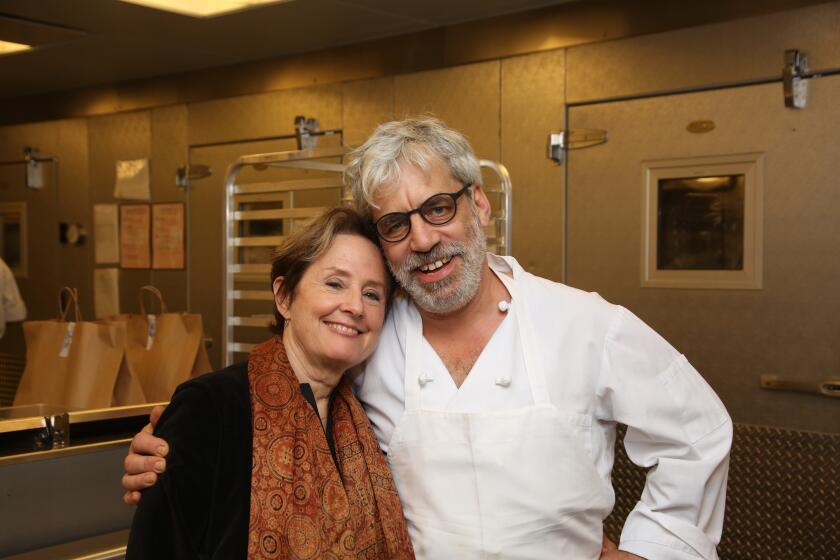Chez Panisse reimagined the way we eat. After 50 years, is that enough?
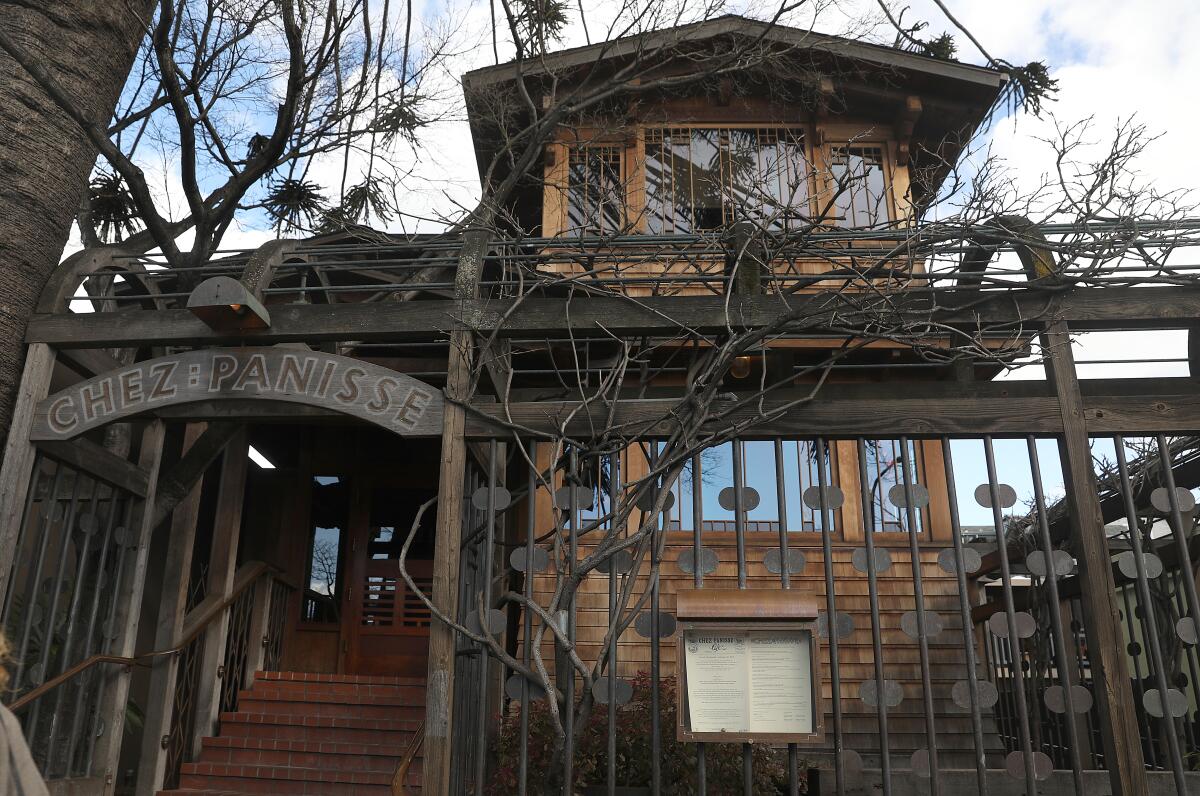
- Share via
On Aug. 28, 1971, a 27-year-old former Montessori teacher named Alice Waters opened a restaurant on Shattuck Avenue in Berkeley.
Waters had studied abroad in France six years earlier and, back home, longed to emulate the notions of hospitality and market-based cooking she’d found there. Her restaurant’s prix fixe menu would change nightly; for the inaugural meal, she served pâté en croûte, duck with olives, a post-entrée salad and slices of plum tart. There were rocky moments — the staff of avid food lovers were for the most part professionally inexperienced, and some guests waited almost two hours for their main course — but overall, as she’s said in interviews over the decades, Waters considered the evening a delicious success.
Chez Panisse turns 50 this month. Its scrappy, dreamy origin has become a legend of American food culture, and the restaurant — the phenomenon that its owner and the many, many people who worked in its kitchens and dining rooms created — molded our nation’s modern culinary sense of self.
Waters’ travel-stoked pursuit of pleasure was intertwined with an ambitious antiestablishment doctrine of sustainability: Buy food grown, raised and fished by local purveyors whose practices tread lightly upon the earth and seas. Serve dishes based on fresh, seasonal, organic ingredients. And we’ll discover that how we eat can change the world.
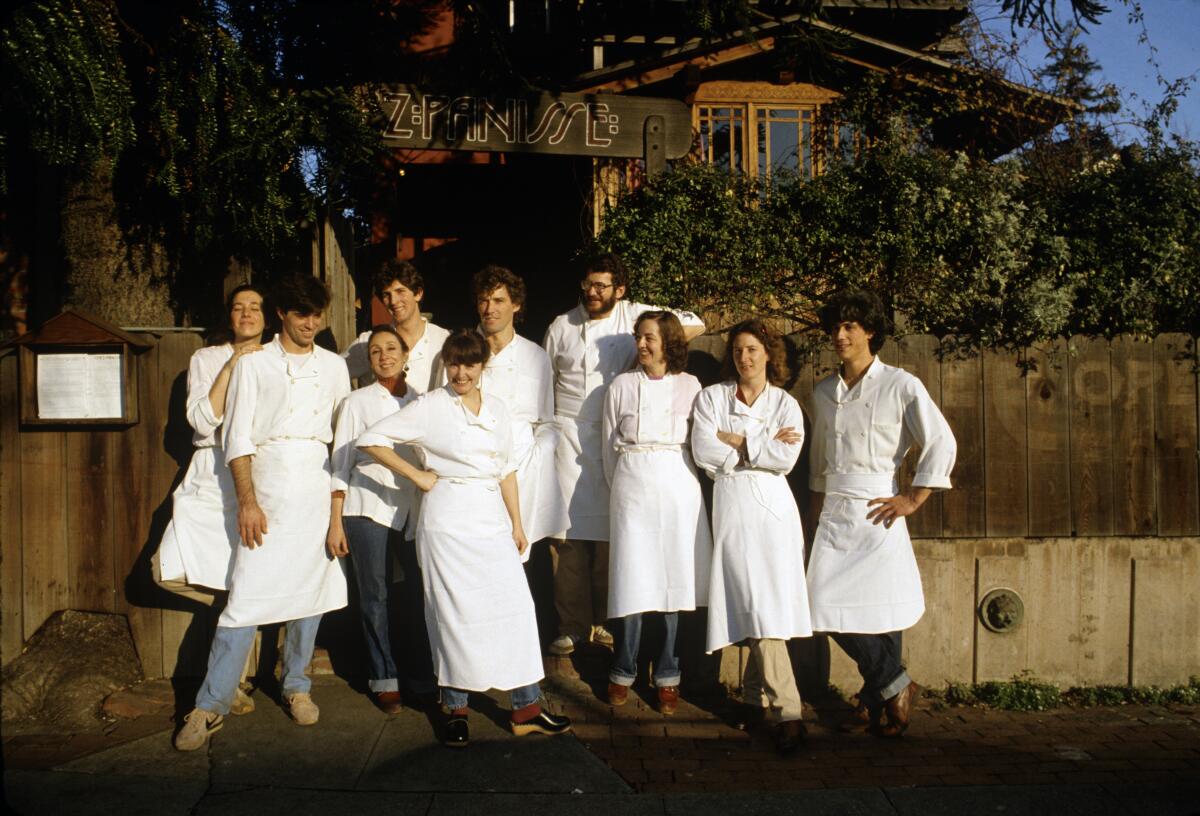
Chez Panisse helped rescue the American palate from midcentury industrial blandness. Farmers markets flourished across the country due to its influence. The restaurant’s gradual turn toward the flavors of the French Mediterranean and Italy helped codify the “California cuisine” of the ’80s and ’90s. Its alumni include some of the country’s most accomplished chef-restaurateurs, bread bakers, cheese makers and cookbook authors.
Waters mothered the farm-to-table movement. She remains a spiritual guide of Slow Food USA. She founded the Edible Schoolyard Project in 1995.
But with longevity and importance come clichés and rebuke. Plenty of us who care about food can no longer utter the phrase “farm-to-table” without rolling our eyes. Waters and Chez Panisse have weathered persistent accusations of culinary elitism, of stifling the Bay Area’s dining evolution with an overbearing dogma, of a precious and stilted adherence to a reductive simplicity that David Chang once famously waved away as “figs on a plate.”
‘Always Home’ author Fanny Singer worries more about running out of garlic than toilet paper.
So much has been written about the place — so many polarized opinions splattered across media through the decades — that my brain whirs in loops when I try to trace my own feelings. Personal affection overlaps with professional assessment. It can be hard to see the forest for the fig trees.
***
Part of the appreciation I feel for Chez Panisse is purely generational. I was born in the spring of 1972, less than a year after the restaurant plated its debut meal. Though it was hugely influential from the beginning, and I was unusually interested in food as a kid, I didn’t hear about Chez Panisse until I was in college. My introduction to its ethos didn’t come directly through Waters: It was through founding pastry chef Lindsey Shere and her forever-wonderful cookbook “Chez Panisse Desserts.”
I saw it on a bookstore shelf during the summer of 1992 while visiting a friend in Ann Arbor, Mich. The town’s tiny farmers market had ripe local peaches and I needed an idea for dessert — not too plain, not too fancy. I liked the look of Shere’s recipe for fruit crisp: ground nuts rather than oats in the topping, with a combination of white sugar and brown sugar. Splashing the sliced peaches with kirsch sounded sophisticated, even if I wasn’t yet old enough to buy alcohol.
During peach season in Maryland, my mother would serve them sliced with whipped cream for dessert or cut them up and freeze them for baking pies in the colder months. The crisp was a new angle for me — a way to appreciate the fruits undisguised, in their blushing, powerfully sweet prime, but also dress them up with texture and spice.
I brought Shere’s book back to my dorm room in Boston, where California felt like an impossible, faraway fairyland. “Summer begins for us with the first cherries late in May. In the upstairs café we bake them into puff pastry tarts in the wood oven,” one chapter begins. She name-checked peach varieties I’d never heard of: Redhaven, Empress, Hale, Suncrest. The desserts had eccentric names: bombe, curd, fool, langues de chats. Shere mentioned quinces and blood oranges and loganberries as if everyone had access to these fruits. I wanted to make contact with this lush, alien world.
When I began interviewing for baking jobs in restaurants a few years later, mentioning Shere’s cookbook proved to be a useful shorthand for explaining who I was. The pastry cook to hire for spun sugar and chocolate towers? Not me. I was a “Chez Panisse Desserts” kind of guy, even if the orchard jewels that Shere advocated for were rarely available (or prohibitively expensive) at the places I worked.
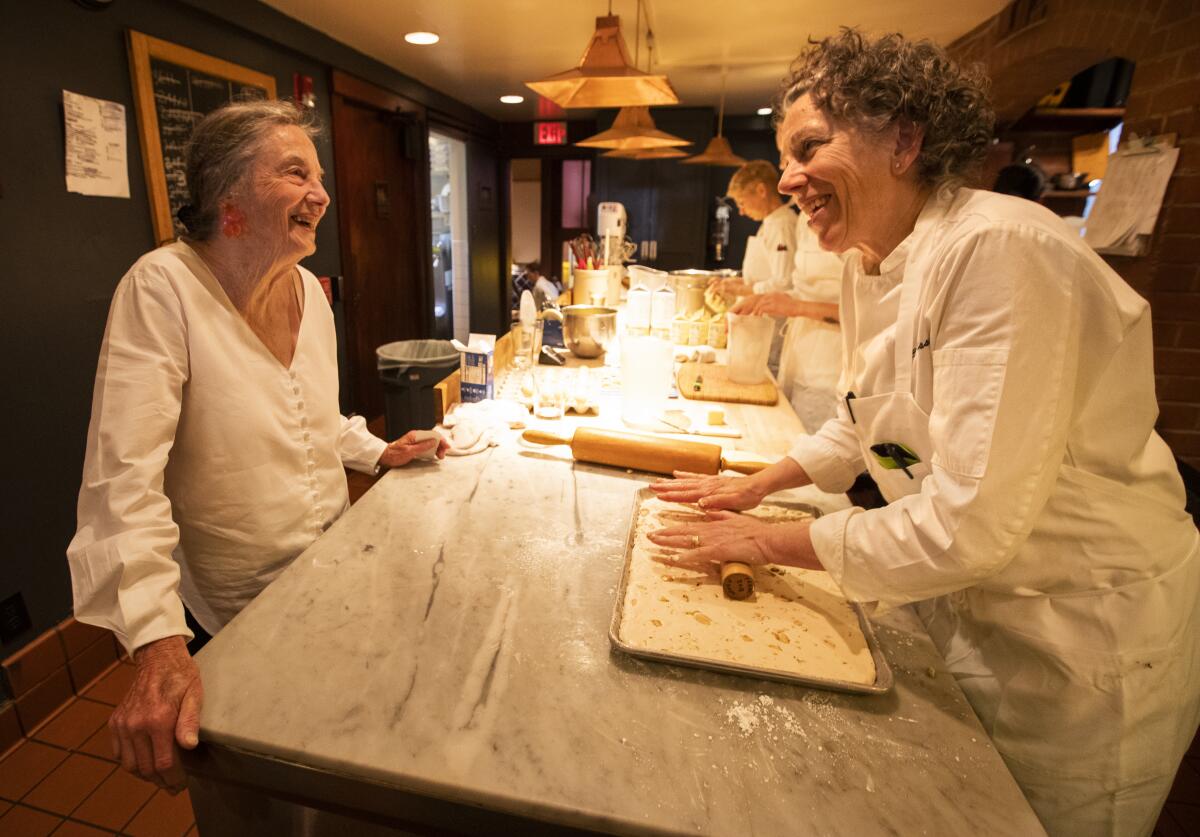
By that point I had acquired other Chez Panisse cookbooks: recipes from the restaurant’s first decade of menus, one showcasing the cooking of the restaurant’s longtime chef Paul Bertolli, a tome dedicated to vegetables. I more fully understood who Alice Waters was in the dining cosmos.
As a restaurant cook, sure, I saw the worth in closing the gaps in our food system between cost and quality and deliciousness. In the day-to-day grind of kitchen work, Waters’ ideals also could seem unreachably lofty. Mostly I made chocolate cakes and crème brûlée and felt some private twinges of joy when things like actually in-season strawberries fit the restaurant budget. Shere liked to make strawberry shortcake with these dark rubies, so I did too.
***
I had my first meal at Chez Panisse on my 26th birthday in May 1998. It was a solo lunch in the upstairs cafe, the more casual offshoot of the downstairs flagship. I had traveled to the Bay Area by myself from Seattle, where I was working in restaurants. I’d saved up for this meal. I splurged on a ridiculous amount of food for one person. It was a pilgrimage, and also an act of cultural extraction: I wanted the maximum possible meaning from the experience.
The cafe (which opened in 1980) has an a la carte menu that, like the restaurant downstairs, changes daily. I still have the one from that day. Here’s what I ate:
Avocado and grapefruit salad with citrus vinaigrette.
North Carolina white shrimp baked in the wood oven with nasturtium vinaigrette.
Baked Sonoma goat cheese with garden lettuces.
Baked local King salmon with ginger sauce, Chino Ranch squash, leeks and carrots.
Rhubarb tart with vanilla ice cream.
Cornmeal cake with strawberries and cream.
I remember that the avocado slices were the silkiest to ever touch my tongue, and I marveled at the salad’s layered citrus flavors. The breading on the baked goat cheese was delicate and herby; the cheese itself was shaped into a precise rectangle and had the airy richness of a soufflé.
Desserts made the most profound impression. Rhubarb had always been something to pair with strawberry almost as a filler: This was the first time I appreciated its clean, sour-tangy flavor on its own. The cornmeal cake, with its subtle crunch, reminded me of the South (where I’d lived previously in my itinerant 20s and would soon return).
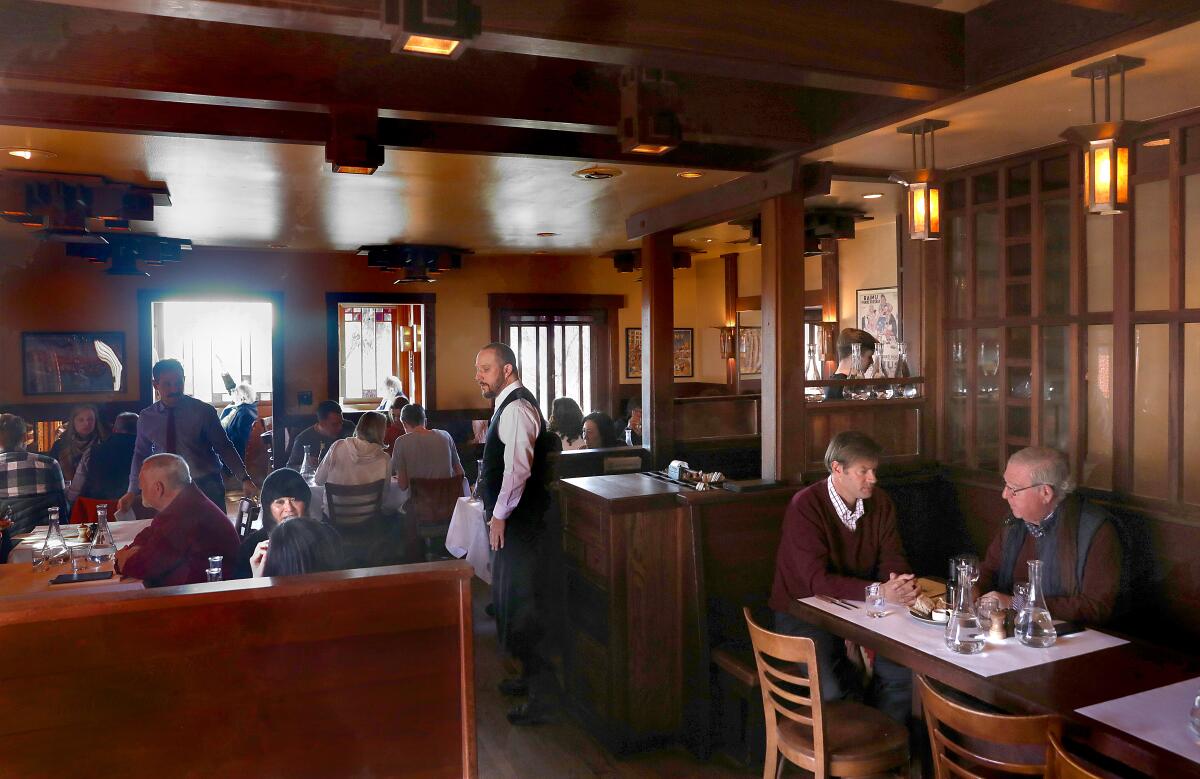
The daily fruit bowl was a famously unembellished selection of sorted-through produce, the moment’s most perfect possible expression of California bounty. It was grapefruits and oranges that first meal — too repetitive after the salad, or I would have asked for it too.
Every dish breathed freshness. The room was bright and enveloping and the server treated me with the doting kindness one gives a young diner having a celebratory meal alone. And yet. I had to admit to myself that the food slightly fell short of my expectations. I’d settled into my seat anticipating transcendent, almost otherworldly intensity from every bite. Instead I endured mere perfection. It’s the risk when a real, working restaurant ascends into cultural lore. It can be the most glorious food on Earth, but it will still always simply be food.
***
“So, what did you think?”
My then-partner (he’s a private man; I’ll call him Samuel) and I had just passed beneath Chez Panisse’s arching wooden sign on our way out the door. I’m leaping ahead to May 2014, a dozen years into my food writing career — and my first month on the job as the national critic for Eater. The framework of the role was to compile an annual list of the 38 essential restaurants in America, a formidable undertaking. To begin the task, I flew directly to California, first to eat my way through Los Angeles and then on to the Bay Area.
Samuel had joined me for the San Francisco leg — I wanted specifically to bring him to Chez Panisse. He enjoyed dining in restaurants with me but found zero attraction to the cult of food. On his own, he’d go to Outback Steakhouse and order trout. He couldn’t recall ever hearing of Chez Panisse or Alice Waters. I took him to the downstairs restaurant, curious for his blank-slate opinion.
“It felt like eating at someone’s home,” he said, responding to my prompt after dinner. “I mean, it didn’t really seem like restaurant food.”
I remember laughing. “Well, I guess that is sort of the point of the place.”
The spring menu that night leaned on the light and rustic: a little plate of yellowtail jack crudo with crushed grapefruit to start; a mound of risi e bisi — rice and peas — crowned with a few ringlets of grilled Monterey Bay squid; misshapen hunks of grilled King salmon with saucy morels, leeks braised in red wine, a tuft of salad greens and a few stalks of asparagus; and strawberries and rhubarb arranged in an endearingly lopsided pastry shell.
I’d been to the downstairs restaurant twice before in the years since that initial birthday meal in the cafe. I always left with the same feeling — that I’d been served food created and cooked with great care, and that I felt very welcomed and relaxed among gleaming redwood paneling (reclaimed, of course) softly lit and shadowed by geometric copper light fixtures. And, wrapped under and around that, the feeling that perhaps I’d only just missed something extraordinary, that probably the menu the night before had been more rich and exciting and exacting, that maybe I’d caught the kitchen on an off night.
The cooking in the cafe was, in my experience, more energized over the years than the finer dining downstairs. A few days after my dinner with Samuel, I returned with a friend for lunch upstairs. Poached halibut with saffron rice, gingered spinach and a dollop of coconut-coriander chutney gave off sparks of spice that seemed downright racy for Chez Panisse. Lindsey Shere retired in 1998 but I felt the gift of her genius presiding over the flaky shortcake with a strawberry-rhubarb compote, the honey-yogurt sherbet with roasted blueberries and a truly spectacular slice of apricot galette; the fruit’s flavor was a floral liqueur.
Spritzy tangerines and fudgy dates comprised the day’s fruit bowl. They were perfect, naturally.
The cafe at Chez Panisse showed up on my first list of 38 essential national restaurants for Eater. It slipped off in later years. The more I knew of the country — the more I ate cooking of chefs like Niki Nakayama in Los Angeles, Mashama Bailey in Savannah, Diana Dávila in Chicago, Nina Compton in New Orleans, Corey Lee in San Francisco and Kwame Onwuachi in Washington, D.C., chefs who fused beautiful ingredients with dishes that conveyed a personal, timely narrative — the less I thought about Chez Panisse. It had sown the seeds of modern American cuisine, but it was no longer at the forefront.
In 2019, Soleil Ho began her tenure as the restaurant critic for the San Francisco Chronicle. She made her debut with a blockbuster drop of five simultaneous reviews, including an appraisal of Chez Panisse. Ho was fair and direct: She found the presentation of the food downstairs haphazard and the cooking upstairs patchy. More important, she asked the tough questions that arise when a restaurant is also a philosophy.
“Chez Panisse has pushed the culinary conversation in this country forward, but then seems to have stood still since then,” Ho wrote. “Contemporary voices in the food industry, like East Bay Ohlone chef Vincent Medina and Oakland’s own People’s Kitchen Collective, have asked important questions of the movement: Whose land is this? Who’s invited? Who can afford to eat here?”
I found myself nodding pretty much the whole time I read her piece. And she did really love the fruit bowl.
***
Chez Panisse’s dining rooms have been closed for the duration of the pandemic, though like so many businesses it began offering weekly takeout. (The to-go fruit bowl according to this week’s posted menu: “Frog Hollow Farm nectarine, Flavor King pluot and Dirty Girl Farm strawberries.”) The plan is for indoor dining service to resume in October, though of course the raging Delta variant could affect the reopening.
Meanwhile, Waters is preparing to open her first venture outside Berkeley: a restaurant in L.A.’s Hammer Museum. David Tanis, a longtime Chez Panisse chef who left in 2011 to write a New York Times column and author cookbooks, is reuniting with Waters to lead the kitchen.
The well of notable Chez Panisse veterans is deep. Here are several to know.
The forthcoming restaurant’s working name is Lulu, in honor of Lulu Peyraud, the matriarch of the family that runs the Domaine Tempier vineyard in the Bandol region of southeastern France. Peyraud was a great friend of Chez Panisse. Richard Olney, whom Waters cites as one of Chez Panisse’s formative influences, wrote a sumptuous cookbook about Peyraud, “Lulu’s Provençal Table,” published in 1994.
I discovered the writing of Olney — a contrarian gay man who was an amazing cook, wine expert and American expat who lived many decades on a hillside in Provence — via mentions of him in the Chez Panisse cookbooks of the ’90s. I was fascinated by the freedom with which he lived his life — some of it described in his posthumously published memoir, “Reflexions.”
Is the greatest legacy of Chez Panisse on the page rather than on the plate? The blurred lines of homey cooking, community symbiosis and professional skill that the restaurant embodies come into clearest focus in cookbooks. Chez Panisse may live on most usefully and poignantly in the words of the chefs who’ve graduated from its kitchens. Samin Nosrat’s “Salt Fat Acid Heat” might be the most exuberant and approachable book on cooking technique written in the English language. David Lebovitz, writing definitively on dessert and on his life in Paris, is the less-grouchy Olney of our generation. The poetry with which Tamar Adler considers her cooking life in “An Everlasting Meal” never gets stale. Hometown L.A. hero Suzanne Goin reached a national audience with her “Sunday Suppers at Lucques,” a distillation of menus from the weekly, deeply welcoming dinner series (served at her now-closed flagship restaurant) that built on the Chez Panisse ethos in her own style.
But see how easy it is to digress on the subject of America’s most famous restaurant? The branches of its family tree are endless.
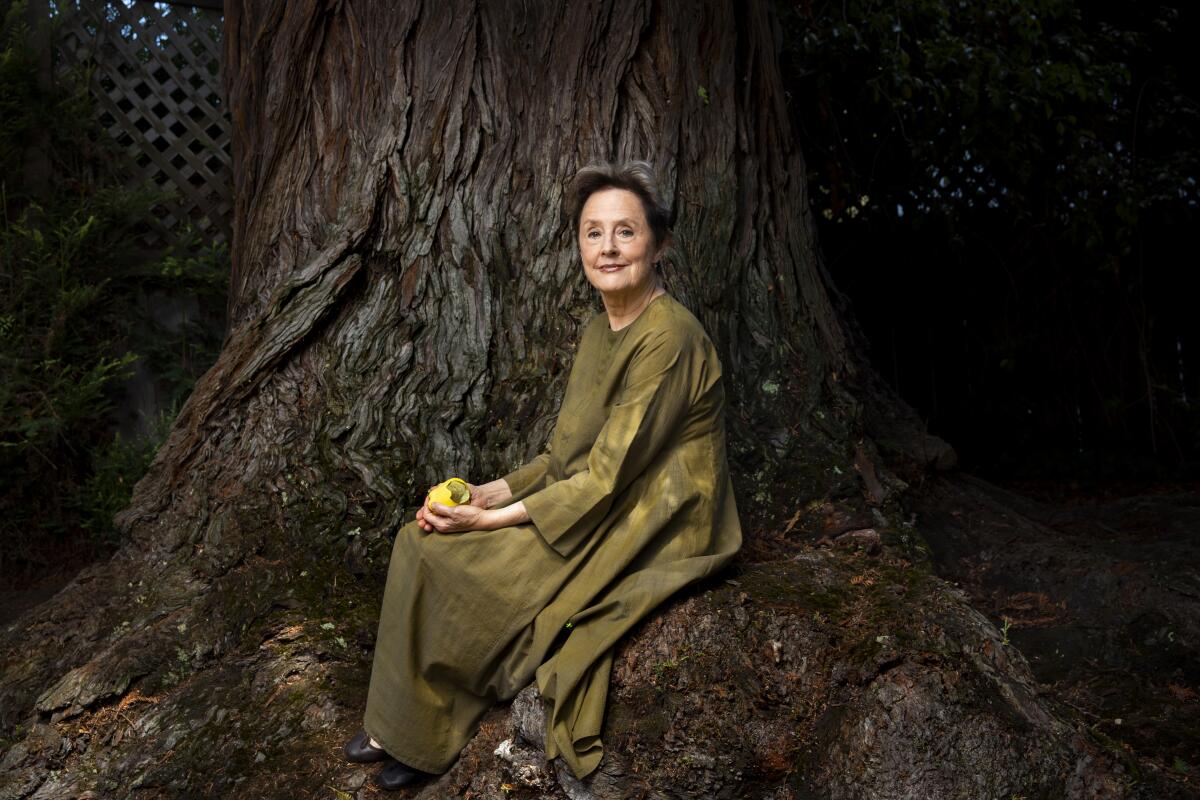
On the eve of Chez Panisse’s golden anniversary, it’s nearly impossible to tease apart the double helix of the restaurant’s identity and Waters’ ubiquity. With Waters I wonder about succession: Beyond the books she writes, who might she mentor as leaders to address the failings in the restaurant industry so blatantly exposed during the pandemic? Who from her lineage might step up to help restaurant owners create more sustainable models of success? Who could she empower to start untangling the snarled equations of industrywide fair wages? Or conceive of a power structure that moves past the played-out era of the chef as auteur?
As for the lovely, legendary converted Craftsman house at 1517 Shattuck Ave.? It likely will thrive for decades to come, indifferent to critics. Chez Panisse is the ouroboros of American restaurants. Part of me wants to vie for a reservation when its doors reopen. After 17 months of isolation and division and social crises, a pleasant meal at an old friend’s house sounds restorative.
Then again, I could pull down a few timeless books from the shelf and host a meal myself.
More to Read
Eat your way across L.A.
Get our weekly Tasting Notes newsletter for reviews, news and more.
You may occasionally receive promotional content from the Los Angeles Times.
